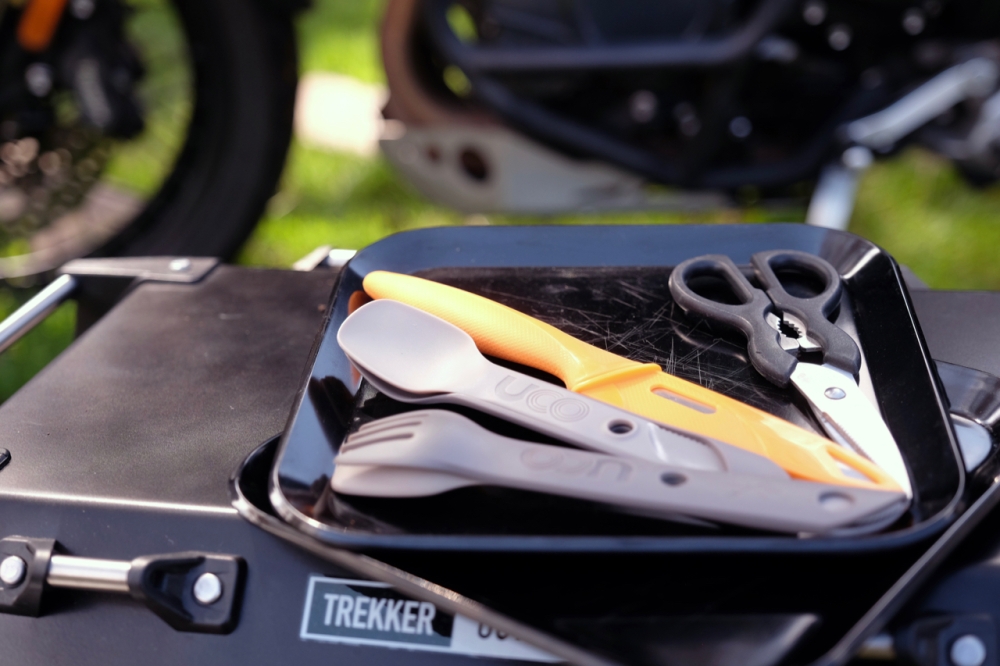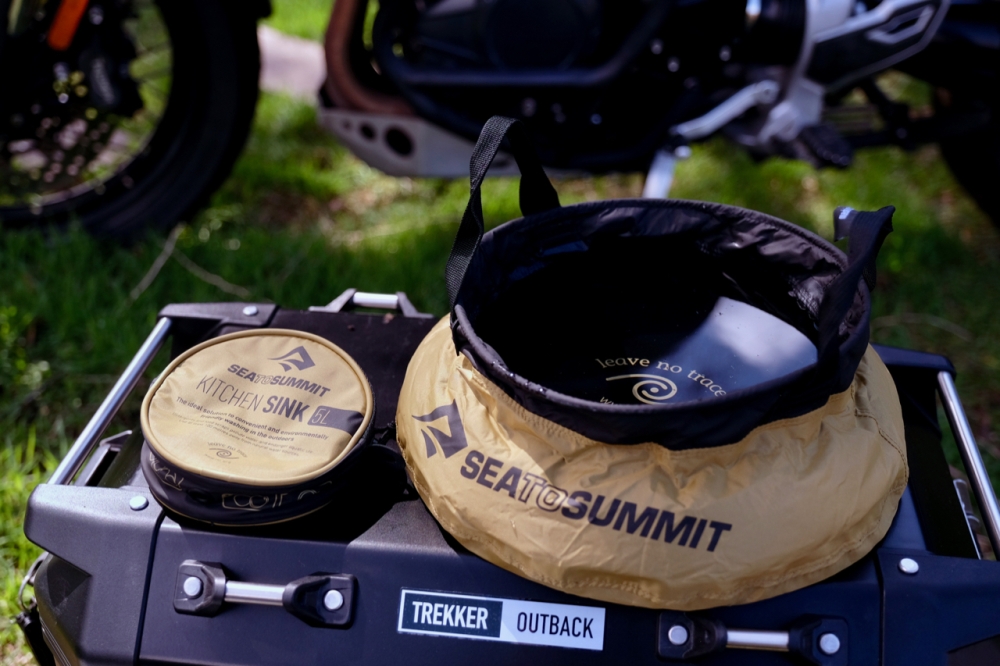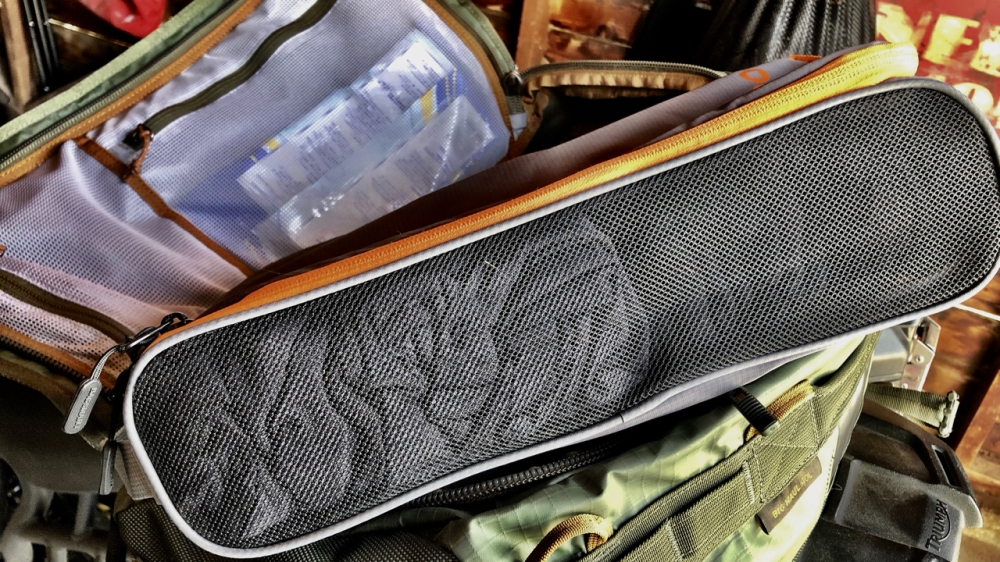Prepping this trip hasn’t been without its challenges. Planning and organizing a 3500 mile trip for two on two ADV bikes, camping most of the way works my OCD in ways nothing else does. And I’ve arguably had too much time to do so, starting in December of 2019, pre-coronavirus, with a launch date in June 2020. This window was chosen for ambient temperatures along our route hovering in the low 70s, what we’ve considered perfect riding and camping and weather.
And it was for the most part.
This post is written post-ride, so there’s some road wisdom on what worked and what didn’t, what became most important and what went way down the list. There weren’t any surprises save for a leaky radiator, which we were able to fix on the road, or at least in a motel paring lot. My main criteria for the value, functionality and durability of gear and machines is to what level I’ve forgotten about it; when it becomes transparent enough to not notice it, and for the stuff we stuffed into the panniers, that was almost everything.
I’ll break this down much like Maslow would, into our hierarchy of motocamping needs; water, coffee, food, shelter, sleep and clothing.
Water

Hydration is key to keeping your wits about you especially in activities that require extra vigilance like riding a motorcycle, not to mention keeping the rest of your organs functioning. And since constant exposure to the atmosphere at a range of speeds dehydrates the rider quickly, the first gear consideration was a hydration system. Both of us are sporting Kriega’s Hydro 3 backpacks. These are sturdy, supportive and well-fitted packs that hold a three liter bladder with a uniquely designed opening without a large screw-top mouth like Camelback, making them easily fillable while still in the backpack. The mouth piece and a 360 bite-valve that sneaks easily inside a full-face helmet for a drink on the go.
For camp water we carried a dromedary bag and an MSR MiniWorks water filter. We used the bag often while camping while the filter never left the pannier, but it was always good to know we had a filter in the event we needed it.


Coffee
Of course, water’s primary purpose is to be a foundation for coffee, a motocamping staple for the two of us. I prefer a fresh grind which was easy to come by with two of my favorite gadgets, the GSI Java Mill and the Fellows vacuum sealing canister.


The Java Mill is a compact but robust grinder that produces grounds suitable for a french press, like the JetBoil Java. Its handle cleverly collapses making the device very easy to pack.

The canister has this neat lid that seal over the top of the canister and when rotated a number of times at about 180 degrees evacuates the air from the canister, reducing any oxidizing of the precious beans inside. There’s a release button on top that allows air back into the can and gives you access to your perfectly stored beans.

We used JetBoil’s Flash Java cooking system with which I was let down. While it, like previous better-made JetBoils, boils water in 90 seconds, the pietzo igniter failed after four mornings and the burner felt like it was going to fall apart. Not impressed.

Food
Fortunately, JetBoil shined with the other products we packed in the panniers; their MiniMo Cooking System and their Flex Ring pot.  The MiniMo has a much better burner that dials in heat settings much better than the Flash’s off/brimstone valve.
The MiniMo has a much better burner that dials in heat settings much better than the Flash’s off/brimstone valve.

Our cooking tools were from GSI’s Crossover Kitchen Set.


Spatula, tongs and a large spoon that fold for packing, a small cutting board, scraper, two fluid bottles and a shaker that holds four spices. There’s a scrubber and towel for clean-up as well. I keep an organic soap in one of the bottles and olive oil in the other. The shaker has salt, pepper, allspice and garlic powder.

The mess kit is for two, thrown together from the bins at WalMart; two acrylic plates, two sets of nesting eating utensils, a paring knife and kitchen scissors. The plate create a clamshell and are held together with elastic hair ties.

Last is the kitchen sink, a 5 liter basin that holds its shape when full and collapses smaller than a hockey puck. This go-to bag is used to fetch water when not using the dromedary bag and is great for kitchen clean up and hygiene.
Shelter
ALPS Mountaineering makes lightweight backpacking tents that have been indispensable in our touring. We use both the Lynx1 and Lynx2 tents with tarp footprints.

Both tents feature a large rainfly for added gear protection outside the tent’s footprint.

The doors a large with built-in screens that are high enough for privacy but large enough for great airflow, with great zippers that glide without binding or catching. Both have windows fore and aft and the Lynx2 has doors on both sides.

Both tents have a ventilation system that’s adjustable depending on desired ambient air temperature and flow.

And there’s a five-in deep, durable pan that keeps the critters and ground water out. We’ve used these tents for seven years as of this writing.
Sleep

Experience shows that sleep-derived adventure is not as fun as well-rested and with that in mind I experimented with a number of products before settling on these items.
The foundation of comfort is the pad and I use the ExPed SynMat.

The pad is insulated with lofted microfiber that protects the sleeping surface from ground temps making this a great four-season pad with an R value of 4.8 out of 5.5. It packs down to a six by ten inch cylinder and its case includes a patch kit and weighs 41 ounces.

It’s made from UV and abrasion resistant, non-slip polyester fabric that shows little wear after seven years of frequent use and is easy to clean.

There’s a built-in hand pump that inflates the pad in a few minutes, though I cheat by using a battery-powered pump that inflates it in seconds.
Atop the pad is the REI Magma 15 down sleeping bag. At a bit under two pounds this bag is roomy with an improved zipper system providing easy in and out without catching or binding.

The top has an insulate yoke that fills the gap around my shoulders and neck with a large hood that accommodates my pillow and keeps it in place.

The footwell has an independent zipper that allows air circulation at the bottom of the bag – the reason I bought this bag to begin with.

The bag has its own loft sack for storage along with a stuff sack, but I went with a Sea-to-Summit compression bag to get the most compact package I could create for pannier space.

The temp rating on the Magma bag (15 degrees) is a good mid-range comfort level for me (I sleep hot), but I also pack two different liners for more extreme conditions.

One is a Sea-to-Summit fleece liner that increases the warmth of the Magma bag.

And the other is a fabric liner that I use as its own sleeping bag when interior temps get above 65 degrees. I just lay it on top of my pad and Magma bag for a cool alternative.
To top it all off I use a Teton Sports ComfortLite Pillow, a self-inflating, insulated pillow.

Its micro fiber surface is easy to clean and like the ExPed pads has been in the panniers for more than seven years now with no indications of wear.
Clothing
I try to keep it simple and sparse with three pair of tops and bottoms for cold climate and the same for warm climate riding. I use wicking polyester and a wicking Merino wool base layer and add fleece and/or down layers as needed.
My shell is an Oxford Montreal 2.0, a three-season, waterproof, multi-liner jacket that performed well on our PNW tour in ambient temps ranging from 45 to 86 degrees and through a number of cloud bursts and constant rain conditions.

The jacket vents well with reinforced and waterproof zippered openings, two on the front, two on the back and two integrated into the sleeves. It has a very comfortable collar with an adjustable clasp, and has two main zippers, even without the liner, to prevent excess air intrusion or to allow more air flow through the main opening.
I upgraded all the armor to C-2. My only gripe is with a hook-latch panel that’s coming undone at the base of the main flap.
I wear a kevlar reinforced riding jean that proved to be more comfortable and public-walk-around stealth than the Oxford Montreal 2.0 pants.
Packing

REI makes the Big Haul 40 duffel bag that coincidently has great features for motorcycle touring and camping, like compression straps on all four corners that double as attachment straps to the back of each Tiger.

But my favorite feature of the bag is that it doubles as a backpack.

Just in case we ever need to bug out with the bikes. The bags are weather resistant so to hedge our bets we used REI’s Ducks Back pack covers that kept the bags dry in the wettest conditions.

Inside the Big Haul bags we used a cube packing system to make searching for specific items easier without having to empty the contents of the bag. This item was one that made living out of a bag more bearable. I’ve seen others made for panniers as well. Brilliant.


